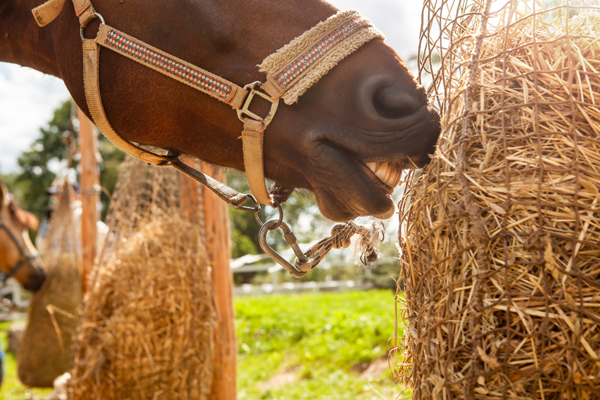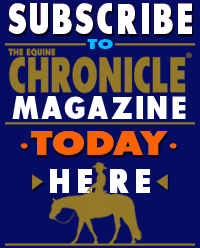
A horse eats hay from a net filled with hay, on a horse ranch, outdoors, on a summer sunny day. Horse muzzle, close-up.
Researchers hypothesized that poor dentition contributes to equine gastric ulcer syndrome (EGUS) due to reduced saliva production secondary to decreased chewing. Although one small study did not find a statistically significant association between dental disorders and EGUS, a comprehensive oral exam is still warranted when ulcers are suspected.*
“We know that chewing stimulates the production of saliva, and that saliva is a natural buffer of stomach acid. Dental issues and oral pain may negatively affect eating behavior and chewing, which may reduce saliva production, diminish gastric buffering, and create more acidic gastric juices,” explained Catherine Whitehouse, M.S., a nutrition advisor for Kentucky Equine Research.
Further, decreased intake of long-stem forage means horses do not have a forage “mat” floating on top of the gastric juices in the stomach. This mat is an effective barrier that stops stomach acid from splashing on the sensitive lining of the upper (squamous) region of the stomach. Repeated exposure of this region to gastric fluid can cause ulcers.
To determine if dental disease is associated with the occurrence of gastric ulcers, 54 horses with a history of recurrent colic, weight loss, loss of appetite, fecal water, exercise insufficiency, or other signs consistent with gastric discomfort (e.g., teeth grinding, girthiness) were identified. Horses underwent gastroscopy to directly visualize the lining of the stomach in both the upper and lower (glandular) regions. If present, the gastric ulcers were scored in each region using a scale from 0 to 4 for squamous ulcers and 0 to 3 for glandular ulcers.
An oral exam was conducted immediately following gastroscopy and a grade from 0 (no specific findings) to 3 (abnormal) was assigned.
In total, 56% of the 54 horses had squamous disease greater than 2 out of 4, 17% had glandular disease greater than 2 out of 3, and 13% of horses had both glandular and squamous disease greater than 2. Further, moderate to severe dental abnormalities were diagnosed in 48% of the 54 horses.
Horses with squamous disease grade 2 or higher or glandular disease grade 2 or higher were prescribed omeprazole, a medication that decreases the acidity of the gastric juices. In addition, the horses’ teeth were floated and the diastemata were cleaned. Diastemata is a synonym for the bars of the horse’s mouth, the naturally toothless areas between incisors and molars on the upper and lower jaws. Owners were also provided management recommendations, such as avoiding long periods between feedings.
Omeprazole was initiated in 59% (32/54) horses, and the teeth were treated in 19 horses. All treated horses were advised to have follow-up gastroscopy four weeks later.
Unfortunately, only nine horses returned for follow-up gastroscopy four weeks after being treated with omeprazole, and only two had undergone treatment to correct the dental disorders. While improvements in equine gastric health were recorded in these horses following treatment, researchers did not observe a statistically significant association between dental disorders and EGUS.
The researchers wrote, “Although our results do not show a direct relationship between dental disorders and EGUS, a gastric and oral cavity examination should be considered in patients with signs of weight loss or inappetence. Further studies with a larger number of cases and a longer study period are required.”
“For horses with dental challenges or horses receiving mostly processed forages that require less chewing than long-stem forages, a daily digestive buffer will help support gastric health by neutralizing excess acid,” recommended Whitehouse.
Routine dental examinations by a qualified professional are an essential management practice. When left untreated, dental disorders can have a negative impact on horse health, behavior, and performance.
*Lensing, R., C. Wirth, F. Thünker, R. Merle, and A.K. Barton. 2024. Association of equine squamous and glandular gastric disease with dental status in 54 horses. Animals (Basel) 14(22):3189.










